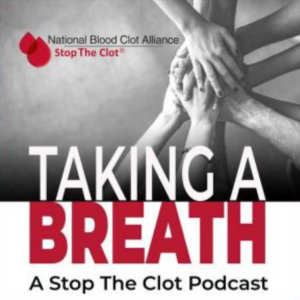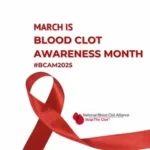Taking a Breath: A Stop the Clot Podcast

Taking a Breath is an award-winning podcast that shines a light on real-life experiences of blood clot survivors. With input from the medical community, each episode shares information on prevention and symptom awareness, helping increase recognition among the general public and ultimately saving lives.
Taking a Breath Episodes
Season 2, Episode 10
Dancer Charly Barby was preparing to audition for Dallas Cowboys Cheerleaders when she was diagnosed with a pulmonary embolism. She shares how this traumatic experience inspired her to spread awareness.
Season 2, Episode 9
Lauren Brzozowski, Olympic hopeful for Team USA bobsled, was celebrating a great season with her team when she broke a bone in her foot while dancing. This, combined with long days of travel, resulted in a DVT that put her career on pause. Lauren shares how she got through this with support from her family and her fans.
Season 2, Episode 8
Moments after Aaliyah Walker delivered twins by C-section, she told her husband, “I can’t breathe,” then she lost consciousness. Aaliyah had suffered a massive saddle pulmonary embolism and a right ventricular (RV) thrombus, or a blood clot in the right ventricle of the heart. She and her husband Brady share their story of how they recovered as a family.
Season 2, Episode 7
As a professional distance runner, Sage Canaday knows his body very well, but he faced an unprecedented roadblock when he began experiencing symptoms of a blood clot: back pain, shortness of breath, and lightheadedness. He describes his ordeal and how he got back to exercise after this life-changing experience.
______________________________________________________________________________________________
Season 2, Episode 6
Loren Ridinger, entrepreneur and co-founder of Market America and SHOP.com, shares her grief over losing her husband and business partner of more than three decades, JR Ridinger, from a pulmonary embolism while sailing in Croatia. She has a new book, “Scrambled or Sunny Side Up? Living Your Best Life After Losing You Greatest Love,” which is out now.
_______________________________________________________________________________________________
Season 2, Episode 5
Dave Hall, morning anchor for Fox 5 in Las Vegas, describes how a game of pickleball led to an injury that eventually resulted in a pulmonary embolism. To spread awareness, he went public with his experience and found common ground with viewers who have also suffered from blood clots.
____________________________________________________
Season 2, Episode 4
Teri Stanfield’s 21-year-old son Bryce, a college football player with dreams of becoming a dentist, died of a pulmonary embolism in February 2024. She tells her story and her discusses why she is driven to spread awareness.
___________________________________________________________________________________________
Season 2, Episode 3
After undergoing surgery to treat prostate cancer, Michael Philbin was faced with another setback: deep vein thrombosis and pulmonary emboli. He discusses how he navigated these conditions and why he was motivated to raise awareness.
____________________________________________________________________________________________
Season 2, Episode 2
Deveraux and Kristie Hubbard lost their 19-year-old son, Deveraux Hubbard II, to a pulmonary embolism in 2013. In the wake of this tragedy, the Hubbards started the Deveraux Hubbard II Foundation to raise awareness and prevent other families from experiencing the same heartbreak.
________________________________________________________________________________________________
Season 2, Episode 1
In the first episode of Season 2, we hear again from Todd Robertson, NBCA’s patient liaison and co-host of this podcast. Todd gives an update on his latest struggle with DVT and how he stays positive about the future.
_________________________________________________________________________________________________
Season 1, Episode 12
In this Season 1 Finale, we hear the story of Todd Robertson, NBCA’s patient liaison and co-host of this podcast. Todd talks about his blood clotting disorder, factor V Leiden, and the impact it has had on his life, including a seventh DVT.
__________________________________________________________________________________
Season 1, Episode 11
Bonnie Bernstein, former sports broadcaster with ESPN and CBS Sports, describes how her DVT and PE diagnosis 18 years ago has affected her life.
__________________________________________________________________________________
Season 1, Episode 10
Dr. Mark Lewis, gastrointestinal oncologist and a survivor of both cancer and blood clots, discusses how his experience as a patient has informed how he cares for others with similar diagnoses.
_________________________________________________________________________________________
Season 1, Episode 9
After losing his 23-year-old daughter Emily to a pulmonary embolism, Doug Adkins became determined to establish a standard of care for all blood clot patients. His advocacy resulted in the Emily Adkins Prevention Act, signed into law in Florida in 2023.
____________________________________________________________________________________________
Season 1, Episode 8
Arshell Brooks-Harris, board secretary for NBCA’s Board of Directors, shares the heartbreaking story of how her 32-year-old daughter Leschel died of a pulmonary embolism after undergoing a surgical procedure.
____________________________________________________________________
Season 1, Episode 7
Jennifer Smith, CEO of Everything Podcasts, recalls how breaking her ankle in a Tough Mudder competition led to a blood clot in her calf, or deep vein thrombosis, as well as a diagnosis of post-thrombotic syndrome.
__________________________________________________________________________________
Season 1, Episode 6
Heide Bajnrauh, health policy strategist, describes waking up in the hospital when she was 19 to find her mother and brother at her bedside and learning that she almost didn’t make it through the night. This ordeal, as well as subsequent blood clot diagnoses over the years, resulted in Heide becoming a blood clot awareness advocate. In fact, she appears on our Times Square billboard through the end of March.
___________________________________________________________________________________________
Season 1, Episode 5
ESPN+ Senior Vice President John Lasker recounts the moment he was being discharged from the hospital following treatment for a pulmonary embolism, only to be struck with a resurgence acute of chest pain. This experience, along with a diagnosis of factor V Leiden, set John on a path to advocacy. It was also a call to protect the women in his life.
__________________________________________________________________________________
Season 1, Episode 4
Traci Wilkes Smith, vice president and talent agent at CSE as well as member of NBCA’s Board of Directors, discusses her journey of suffering through symptoms, being misdiagnosed, and how her experience sparked her advocacy.
Season 1, Episode 3
Mimi MacKinnon, director of events for Major League Soccer and a member of NBCA’s Board of Directors, discusses her near-fatal pulmonary embolism that doctors believe was provoked by birth control and her subsequent recovery.
Season 1, Episode 2
Paralympic medalist Tatyana McFadden describes how blood clots affected her life and career and how she found the strength to keep pushing forward.
Season 1, Episode 1
Olympic medalist Katie Hoff discusses how a pulmonary embolism ended her swimming career and how becoming an advocate has helped her heal emotionally.
Trailer
Other Ways to Listen to Taking a Breath
Spotify, Apple, Google, Pandora, EP Studios, iTunes, iHeartRadio, Amazon Music, Tunein, Stitcher, Breaker, Player FM, Deezer, RadioPublic, Overcast, Castro, and Castbox.
About Taking a Breath
Taking a Breath is a new limited-series podcast that shines a light on the dangers of blood clots, breathing life into NBCA’s mission of pushing these preventable killers to the forefront of public discourse. Every month, we’ll present the stories of blood clot survivors like Olympic medalists Katie Hoff and Tatyana McFadden as well as insights from medical professionals. Join us as we collectively stop the clot.
Your Hosts


Questions, comments or suggestions? Email us at info@stoptheclot.org.




